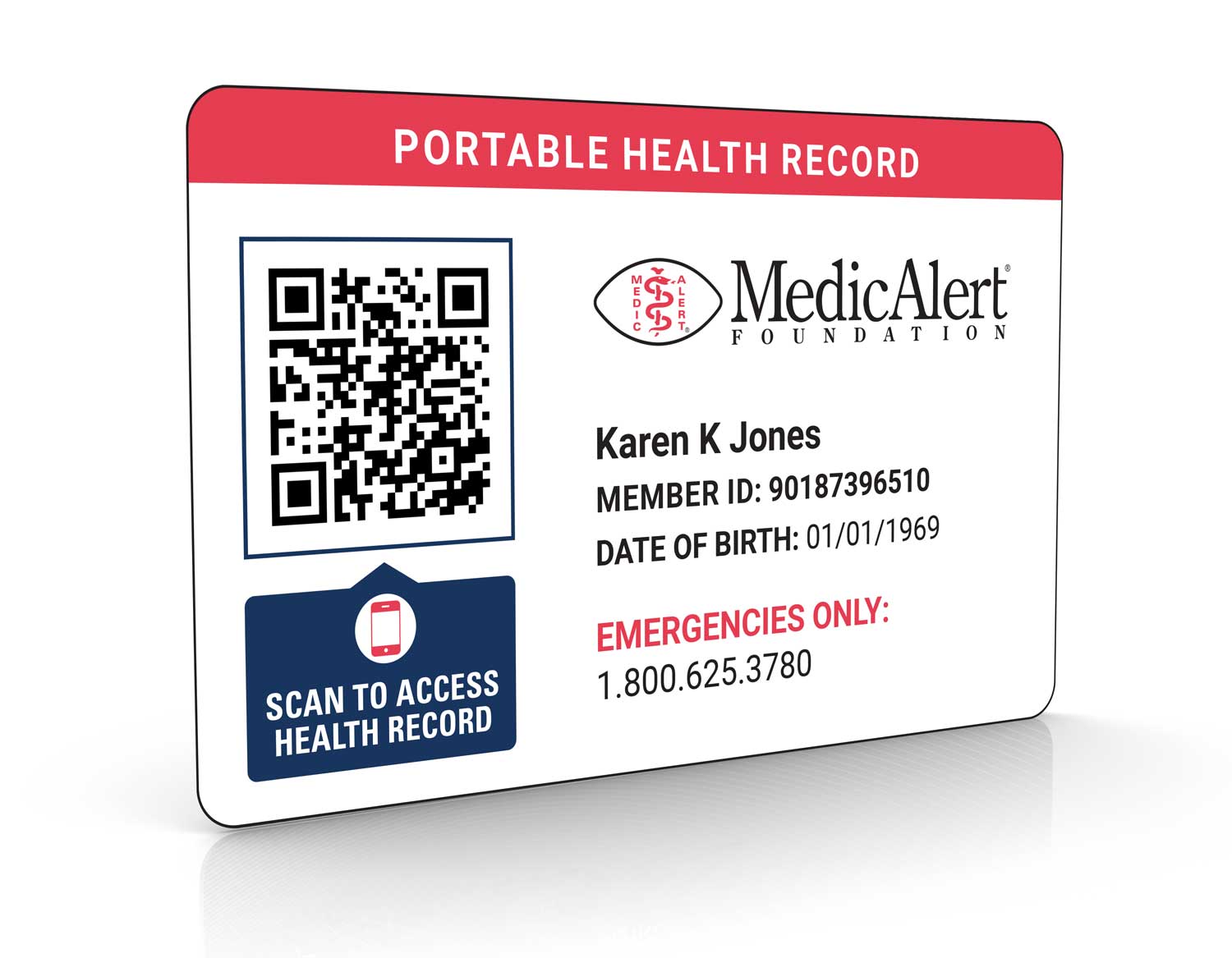The importance of medical ID jewelry is amplified for our community because aortic dissection may not be the first problem that emergency personnel think of, especially in individuals who may be younger and – on the outside – appear to be healthy.
The Marfan Foundation

Medical IDs For Marfan Syndrome
The confidence to live with Marfan syndrome
Marfan syndrome is a genetic condition that affects the body’s connective tissues (i.e., the fibers that bind and support all internal organs and structures). Because connective tissue is found throughout the body, the disorder can attack almost every system, including the heart, joints, skin, blood vessels, and skeleton. In some cases, the lungs, eyes, and nervous system may also be affected.
The damage caused by Marfan syndrome can range from mild to severe. With Marfan syndrome, the walls of the aorta can weaken and stretch, which may lead the aortic valve to leak and tear, or they can develop a bulge, known as an aneurysm. Both occurrences can be life-threatening.
Because Marfan syndrome is difficult to diagnose and can have many different manifestations from mild to life-threatening, it is especially important for those with the condition to have a medical ID for Marfan syndrome.
How MedicAlert protects those living with Marfan syndrome
One thing you shouldn’t worry about is what could happen if there’s an emergency. MedicAlert’s protection plans offer benefits that extend beyond the ID, providing safety and peace of mind for people living with Marfan syndrome, their families and caregivers.

24/7 Emergency Response
Our team provides first responders the information they need to provide fast, accurate care.

Digital Health Profile
All your vital information, all in one place for you and your caregiver.

Emergency Contact Notification
In an emergency, we connect families so that no one is alone in a crisis.

Patient Instructions
Share the information that’s important to your care, such as use of rescue medications or contraindication for tests like MRIs.
Pair a medical ID for Marfan syndrome with the protection plan that’s right for you.
What causes Marfan syndrome?
Marfan syndrome is caused by a defect in a gene called FBN1, which contains instructions for producing a protein known as fibrillin, a major component of connective tissue. A mutation on this gene limits the body’s ability to build healthy and strong connective tissue and is associated with the characteristic physical features present in people with Marfan.
Marfan syndrome is a rare disorder affecting approximately 200,000 people in the United States, including men and women of all races and ethnic groups. Most people with Marfan inherit it from a parent who has the condition, and each child of a parent with Marfan has a 50-50 chance of inheriting the defective gene. However, about 25% of patients with Marfan develop the condition for unknown reasons.
How is Marfan syndrome treated?
Unfortunately, there is no cure for Marfan syndrome because gene mutations cannot be fixed or reversed, so treatment is aimed at managing symptoms as well as preventing potential issues.
People with mild symptoms may not require any treatment other than regular appointments with their doctor to follow the disease’s progression and rule out complications. Others may require close monitoring from a multidisciplinary team of specialists, including cardiologists, ophthalmologists, orthopedists, and geneticists.
Treatments for Marfan syndrome may include:
Medications
People with Marfan syndrome are often prescribed a type of medication called beta-blockers to improve the heart’s ability to relax and prevent or slow down the enlarging of the aorta. Beta-blocker therapy, which is often begun at an early age, can delay the need for heart surgery.
Surgery
Heart surgery may sometimes be necessary to correct aortic valve problems or if the aorta has widened beyond acceptable limits. In severe cases, part of the aorta may need to be replaced to prevent a life-threatening rupture. People with Marfan syndrome also have a higher risk of developing eye problems that could require surgical intervention, like cataracts. Other possible surgeries that may be needed depending on each person’s signs and symptoms include breastbone and spinal corrections.
Lifestyle
Depending on the affected body parts and the extent of the damage, you may need to avoid active sports and strenuous physical activity because they can cause additional heart strain. However, most people living with Marfan syndrome can and should engage in regular low-intensity physical exercise. The Marfan Foundation recommends opting for non-competitive activities over-vigorous sports and staying at an aerobic level of work where you’re able to carry a conversation without getting out of breath.
What to engrave on your MedicAlert medical ID for Marfan syndrome:
MedicAlert offers free custom engraving on all our medical ID products. The engraving on your medical ID for Marfan syndrome should include any critical medical information that can protect and save your life if you are in an accident or have a medical emergency, for example:
- Any severe allergies
- Marfan syndrome
- Risk of aortic dissection if this applies
- Medications you’re currently taking
- Any additional medical information that needs to be communicated to first responders

Sample engraving. Consult our team if you need help engraving your medical ID for Marfan syndrome.
How is Marfan syndrome diagnosed?
Although people with Marfan syndrome are born with it, some aren’t diagnosed with the disorder until adolescence or early adulthood. This is because the condition can be so mild that sometimes it produces very few, if any, symptoms.
Marfan syndrome can be challenging to diagnose because there is no specific diagnostic test to detect the condition. This is despite the fact that scientists have identified both the gene and mutations responsible for the disease.
The diagnosis relies on a set of defined clinical criteria that include a combination of symptoms, family history, and complementary medical tests, such as genetic testing, eye examinations, and heart tests, such as echocardiograms and chest x-rays. If your doctor suspects that you may have Marfan syndrome, they may also order specialized imaging tests, like a CT scan or MRI, to rule out a painful condition called dural ectasia, or a bulging of the lining of the spinal column.
Living with Marfan syndrome
Every person’s experience with Marfan syndrome is slightly different. Often, patients feature distinct physical characteristics, such as a tall and thin physique with long arms, legs, fingers, and toes that may seem out of proportion with the rest of the body. They also may have a long, narrow face, deep-set eyes, and a higher-than-average roof of the mouth with crowded teeth. Additionally, many individuals with Marfan develop spinal abnormalities, such as scoliosis or a curved spine that may cause chronic back pain posture issues.
The damage caused by Marfan syndrome can range from mild to severe. The most dangerous complication involves damage to the aorta (a large blood vessel responsible for carrying oxygen-rich blood from the heart to the rest of the body). With Marfan syndrome, the walls of the aorta can weaken and stretch, which may lead the aortic valve to leak and tear, or they can develop a bulge, known as an aneurysm. Both occurrences can be life-threatening, which is why wearing medical IDs for Marfan syndrome can be so important.
Emotional support for those living with Marfan syndrome
Learning that you or a loved one has a genetic disorder can be extremely difficult. You may be worried about the toll the condition may have on your lifestyle and wonder how the disease will affect your quality of life. Depending on your situation, you may also be concerned about passing the defective gene to your children.
People who have Marfan syndrome, particularly teens and young people, often find it helpful to talk with others facing similar challenges. The Marfan Foundation hosts monthly virtual support groups where people can connect, tell their stories, and share resources and information in an understanding and supportive environment.
How medical IDs for Marfan syndrome combined with MedicAlert Membership protect you 24/7
- We’re your voice: If you can’t speak for yourself due to a medical emergency, your Marfan syndrome bracelet will speak for you – informing others about your Marfan syndrome and any medications you’re taking.
- 24/7 emergency protection: In an emergency, the MedicAlert team will relay all of your critical medical information to first responders, no matter where or when your emergency happens.
- Always connected: You should never be alone in an emergency. That’s why MedicAlert will reach out to your designated contacts if you are unable to do so.
- Live with peace of mind and confidence: MedicAlert will be there for you every step of the way. You’ll have the confidence and freedom to live your life with Marfan syndrome, knowing we’ve got you covered.
DISCLAIMER: THIS WEBSITE DOES NOT PROVIDE MEDICAL ADVICE. The information in this article is presented for educational purposes only and is not intended as a substitute for professional medical advice, diagnosis and treatment. Always seek the advice of a physician or other qualified healthcare provider for any questions you may have regarding a medical condition or treatment.







